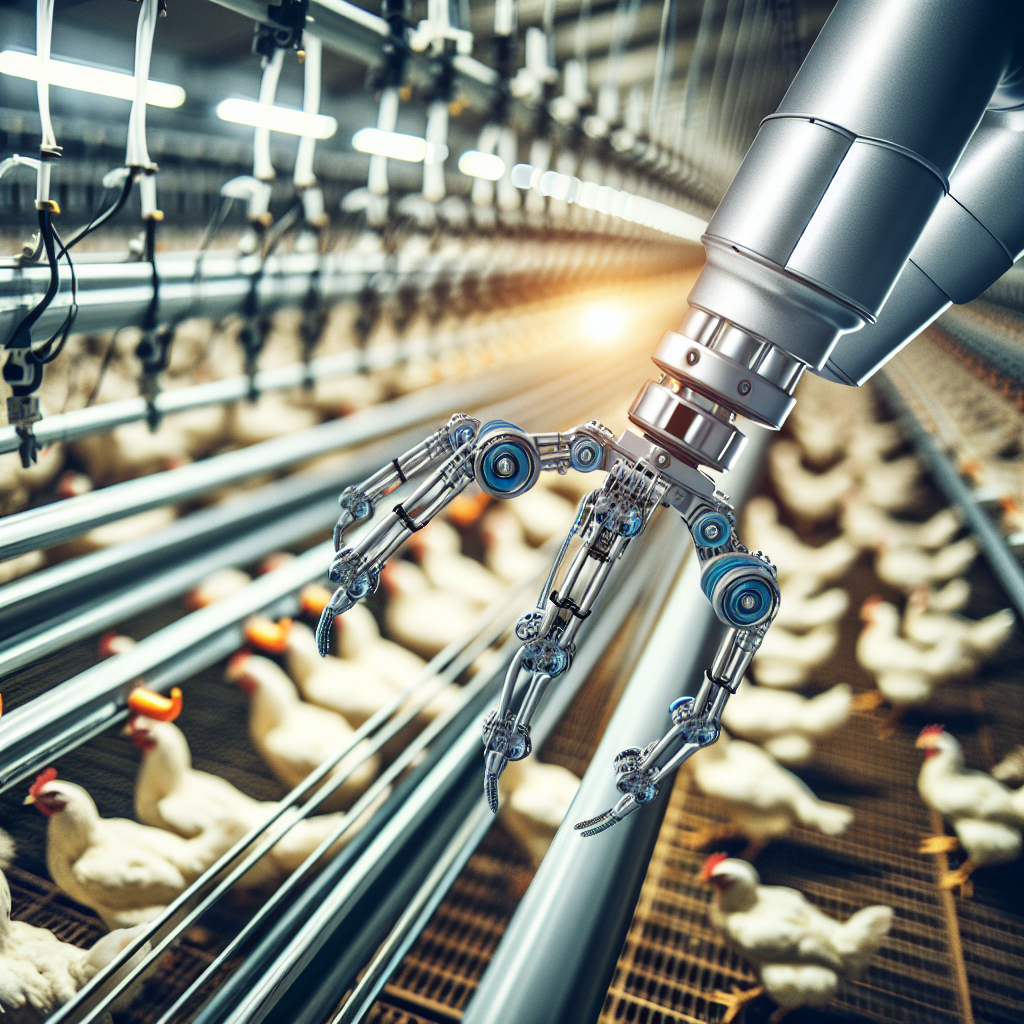In today’s rapidly advancing world, the need for safeguarding our possessions and loved ones has become more crucial than ever. With the ever-evolving landscape of technology, there are now countless innovative solutions available to ensure the security and safety of our most valuable assets. When it comes to protecting your precious coop, you might find yourself wondering how you can utilize these technological advancements to provide the utmost security. Luckily, there are a multitude of options at your disposal, ranging from smart alarms and surveillance systems to remote monitoring capabilities. With these cutting-edge tools, you can rest assured knowing that your coop is well-protected and monitored, allowing you to focus on other aspects of your life with peace of mind.
I. Implementing Access Control Systems
Enhancing the security and safety of your coop begins with implementing access control systems. By strictly controlling who has access to your coop premises, you can significantly reduce the risk of unauthorized entry and potential security breaches.
A. Installing keyless entry systems
One effective way to enhance access control is by installing keyless entry systems. These systems eliminate the need for traditional keys, which can be easily lost or duplicated. Keyless entry systems usually utilize access codes or key cards, which can be assigned to specific individuals. This ensures that only authorized personnel can enter the coop premises, greatly reducing the chances of unauthorized access.
B. Using biometric access solutions
Another advanced access control solution is the use of biometric access solutions. These systems rely on unique biological characteristics such as fingerprints, retinal scans, or facial recognition to grant access. By using biometric data, you can ensure that only authorized individuals who possess the required biological features can gain entry to the coop. Biometric access solutions are highly secure and virtually impossible to forge, offering an extra layer of protection to your coop.
C. Implementing smart locks with remote access
Smart locks with remote access provide an additional level of convenience and security. With these systems, you can control and monitor access to your coop remotely using a smartphone or computer. This enables you to grant or revoke access, monitor entry logs, and receive real-time notifications of any suspicious activity. Implementing smart locks with remote access adds flexibility and peace of mind to ensuring the security of your coop.
II. Enhancing Surveillance Measures
Effective surveillance measures play a crucial role in ensuring the security and safety of your coop. By implementing advanced surveillance technologies, you can deter potential intruders and quickly respond to any security incidents.
A. Installing security cameras
Installing security cameras in strategic locations around your coop can help in deterring criminals and recording any suspicious activities. High-resolution security cameras provide clear and detailed footage, which can be vital evidence in the event of a security breach. Additionally, visible security cameras act as a deterrent, discouraging potential intruders from targeting your coop.
B. Implementing motion sensor technology
Motion sensor technology is an essential component of an integrated security system. By detecting movement in designated areas, motion sensors can trigger alarms or activate security cameras, effectively alerting you of any unauthorized access. This technology is particularly useful during non-operating hours when the coop is less frequently monitored.
C. Utilizing video analytics
Video analytics is a cutting-edge technology that uses artificial intelligence algorithms to analyze live or recorded video footage. This technology can detect and identify specific objects, behaviors, or events, automatically alerting you to potential security threats. Video analytics can provide valuable insights into patterns of behavior, enabling you to identify suspicious or abnormal activities and take appropriate action.
III. Implementing Intrusion Detection Systems
Intrusion detection systems are indispensable in safeguarding your coop against unauthorized access attempts. These systems provide an early warning system, ensuring prompt response to any potential security breaches.
A. Installing intrusion alarms
Installing intrusion alarms is an effective way to secure your coop premises. These systems typically consist of sensors placed on doors, windows, or other access points, which trigger an alarm when breached. Intrusion alarms can be set to emit loud sounds or notify security personnel or property owners directly, ensuring immediate action is taken in response to a security threat.
B. Implementing perimeter security solutions
Protecting the perimeter of your coop is vital in preventing unauthorized access. Implementing perimeter security solutions such as fences, gates, or barriers adds an extra layer of defense. These physical barriers act as a deterrent and can help control and monitor the movement of individuals in and out of your coop, preventing unauthorized entry.
C. Utilizing window and door sensors
Window and door sensors provide an additional level of security by alerting you to any unauthorized entry attempts. These sensors can detect when a window or door is opened or tampered with. When triggered, they can activate an alarm or send a notification to your mobile device, enabling you to take immediate action and mitigate potential security risks.
IV. Employing Smart Lighting Solutions
Smart lighting solutions not only enhance convenience but also significantly contribute to the security and safety of your coop. By using automated lighting systems, you can create an illusion of occupancy, deter potential intruders, and improve visibility around your premises.
A. Installing motion-activated lights
Motion-activated lights are an excellent security feature for your coop. These lights automatically turn on when motion is detected, illuminating the area and discouraging unauthorized access. By installing motion-activated lights in strategic locations such as entry points or dark areas, you can enhance the visibility and security of your coop, making it less attractive to criminals.
B. Utilizing smart lighting schedules
Smart lighting schedules allow you to automate the turning on and off of lights at specific times during the day or night. By simulating typical occupancy patterns, you can create the appearance that someone is present at all times, even when your coop is unoccupied. This can deter potential intruders by giving the impression that your coop is constantly monitored and increase the overall security of your premises.
C. Implementing remote-controlled lighting systems
Remote-controlled lighting systems provide convenient control over the lighting in your coop. These systems allow you to turn the lights on or off, adjust brightness levels, or change color schemes from a remote location using a smartphone or computer. Remote-controlled lighting systems offer flexibility in managing lighting, ensuring that you can maintain a well-lit and secure environment for your coop.
V. Utilizing Remote Monitoring and Control Systems
Remote monitoring and control systems enable you to have complete visibility and control over your coop’s security even when you are away. By utilizing these technologies, you can monitor the status of your coop, control various security features remotely, and receive real-time alerts in case of any emergencies.
A. Implementing home automation systems
Home automation systems offer a comprehensive solution for remote monitoring and control of your coop. These systems integrate various security features, such as access control, surveillance, lighting, and temperature control, into a single platform. By accessing the home automation system through a mobile app or web interface, you can monitor and manage your coop’s security settings from anywhere.
B. Utilizing mobile apps for remote access
Many security systems now come with accompanying mobile apps that allow you to remotely monitor and control various security features. By installing these apps on your smartphone or tablet, you can receive real-time notifications, view live video feeds, or control access to your coop. Mobile apps provide a convenient and user-friendly way to stay connected to your coop’s security, even when you are not physically present.
C. Employing smart sensors for real-time monitoring
Smart sensors play a crucial role in real-time monitoring of your coop’s security. These sensors can detect various events, such as temperature changes, water leaks, or even the presence of smoke or gases. By integrating smart sensors into your security system, you can receive instant notifications and take immediate action to mitigate potential risks or damages.
VI. Protecting Against Cyber Threats
In today’s interconnected world, it is equally important to protect your coop’s digital assets from cyber threats. By implementing robust cybersecurity measures, you can safeguard your coop’s data, privacy, and infrastructure from potential attacks.
A. Utilizing strong passwords and two-factor authentication
One of the simplest yet impactful ways to protect against cyber threats is by utilizing strong passwords and implementing two-factor authentication (2FA). Use complex and unique passwords for all your accounts, including WiFi networks and administrative access. 2FA provides an extra layer of security by requiring a second verification factor, such as a code sent to your mobile device, in addition to a password.
B. Regularly updating software and firmware
Regularly updating software and firmware is crucial in mitigating potential vulnerabilities and ensuring your coop’s security. These updates often address known security flaws and provide patches that protect against new threats. Keep all software, including operating systems, antivirus programs, and smart devices, up to date to minimize the risk of exploitation by cybercriminals.
C. Employing network security measures
Proper network security measures are vital to protect your coop’s digital assets and information. Set up firewalls to control incoming and outgoing network traffic and implement intrusion detection systems to identify and block suspicious activities. Use secure and encrypted WiFi networks, and segment your network to restrict access to sensitive information. Regularly monitor and audit your network for any unusual activity or potential breaches.
VII. Implementing Fire Safety Solutions
Fire safety is a critical aspect of ensuring the overall security and safety of your coop. By implementing appropriate fire safety solutions, you can minimize the risk of fire incidents and ensure timely response in case of emergencies.
A. Installing smoke detectors and fire alarms
Installing smoke detectors and fire alarms is essential to early fire detection and prompt response. These devices can sense smoke or an increase in temperature and trigger an alarm, alerting you and others of a possible fire. Place smoke detectors and fire alarms strategically throughout your coop, ensuring comprehensive coverage and maximum effectiveness.
B. Utilizing fire suppression systems
Fire suppression systems provide an effective means of containing and extinguishing fires before they spread. Various fire suppression technologies, such as sprinkler systems or gas suppression systems, can be installed in critical areas of your coop. These systems are designed to automatically activate when a fire is detected, quickly suppressing the flames and reducing potential damages.
C. Implementing emergency evacuation plans
Having well-defined and regularly practiced emergency evacuation plans is crucial for the safety of individuals within your coop. Ensure that all coop members are aware of evacuation routes, meeting points, and emergency procedures. Conduct regular drills to familiarize everyone with the evacuation process, and regularly review and update the plans based on any changes or new hazards.
VIII. Ensuring Data Privacy and Encryption
Protecting sensitive data and ensuring secure data storage and transmission are essential components of maintaining the security and privacy of your coop. By implementing data privacy and encryption measures, you can prevent unauthorized access and safeguard your coop’s confidential information.
A. Implementing data encryption protocols
Implementing data encryption protocols is crucial to protect sensitive information from unauthorized access or interception. Encrypting data involves converting it into a secure format that can only be decrypted with the correct encryption key. Use encryption technologies such as SSL/TLS protocols for websites, encrypted communication channels for remote access, and encrypted storage solutions for sensitive data.
B. Regularly backing up data
Regularly backing up your coop’s data is essential in ensuring its recovery in case of data loss or security breaches. Implement a robust backup strategy that includes regularly scheduled backups of critical data to separate storage devices or cloud-based backup services. Test the backup restoration process periodically to verify its effectiveness and make necessary adjustments as needed.
C. Ensuring secure data storage and transmission
Securing data storage and transmission is vital to prevent data breaches or unauthorized access. Implement access controls and user permissions to restrict access to sensitive data. Ensure that data is securely transmitted over networks using encryption technologies such as SSL/TLS. Implement secure file transfer protocols for sharing confidential files and use secure cloud storage solutions that prioritize data security.
IX. Conducting Regular Security Audits
Regular security audits are essential to evaluate the effectiveness of your coop’s security measures and identify any vulnerabilities or weaknesses. By conducting thorough assessments, you can ensure that your coop’s security remains up to date and address any potential gaps in your security system.
A. Evaluating existing security measures
Start by evaluating the effectiveness of your existing security measures. Assess the functionality and performance of your access control systems, surveillance systems, intrusion detection systems, and other security technologies. Identify any areas where improvements can be made and analyze the overall effectiveness of your current security setup.
B. Identifying vulnerabilities and weaknesses
During security audits, it is vital to identify any vulnerabilities or weaknesses in your coop’s security. This can involve conducting penetration testing, vulnerability assessments, or risk assessments. Identify potential entry points, weak access controls, or outdated technology that could compromise your coop’s security. Highlight any areas that may need additional attention or improvements.
C. Implementing necessary improvements
Based on the findings from security audits, implement necessary improvements to address any vulnerabilities or weaknesses. This may involve upgrading existing security systems, implementing additional security measures, or providing additional training to coop members. Regularly review and update your security protocols and stay informed about the latest security trends and best practices.
X. Educating and Training Coop Members
Ensuring the security and safety of your coop is a collective effort that involves educating and training all coop members. By creating a security-conscious culture, you can enhance awareness and promote responsible behavior when it comes to utilizing technological solutions.
A. Conducting security awareness programs
Conduct regular security awareness programs to educate coop members about the importance of security and safety protocols. Provide training and resources on topics such as access control, surveillance systems, cyber threats, and emergency procedures. Encourage coop members to report any suspicious activities or potential security risks promptly.
B. Training members on technology usage
Proper training on the usage of technological solutions is essential to maximize their effectiveness. Train coop members on how to operate access control systems, surveillance cameras, or mobile apps for remote monitoring. Ensure that everyone understands the purpose and functionality of the implemented security technologies and knows how to respond in case of any security-related incidents.
C. Promoting a security-conscious culture
Foster a security-conscious culture within your coop by promoting responsible security practices among all members. This can include regularly reminding everyone to lock doors, arm security systems, or update passwords. Encourage open communication about security concerns and provide channels for reporting and addressing potential security threats. By promoting a security-conscious culture, you can significantly enhance the overall security and safety of your coop.
In conclusion, ensuring the security and safety of your coop using technological solutions requires a comprehensive approach. By implementing access control systems, enhancing surveillance measures, employing intrusion detection systems, utilizing smart lighting solutions, utilizing remote monitoring and control systems, protecting against cyber threats, implementing fire safety solutions, ensuring data privacy and encryption, conducting regular security audits, and educating and training coop members, you can create a secure environment for your coop and effectively mitigate potential risks. Remember, a strong security foundation is built upon the careful integration of multiple technologies and a proactive commitment to maintaining and improving security measures over time.




